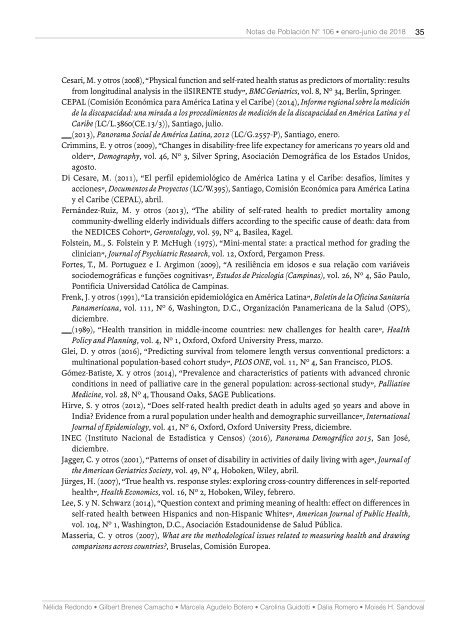Notas de Población N° 106
El número 106 de Notas de Población está conformado por 10 artículos, en cuya elaboración han participado 21 colaboradores. Los artículos abordan diversos temas de investigación relacionados con la mortalidad, el transnacionalismo migratorio y la fecundidad de las migrantes, así como la fecundidad adolescente, el femicidio, la migración de retorno, la segregación en el espacio urbano y el dividendo demográfico.
El número 106 de Notas de Población está conformado por 10 artículos, en cuya elaboración han participado 21 colaboradores. Los artículos abordan diversos temas de investigación relacionados con la mortalidad, el transnacionalismo migratorio y la fecundidad de las migrantes, así como la fecundidad adolescente, el femicidio, la migración de retorno, la segregación en el espacio urbano y el dividendo demográfico.
You also want an ePaper? Increase the reach of your titles
YUMPU automatically turns print PDFs into web optimized ePapers that Google loves.
<strong>Notas</strong> <strong>de</strong> <strong>Población</strong> <strong>N°</strong> <strong>106</strong> • enero-junio <strong>de</strong> 2018<br />
35<br />
Cesari, M. y otros (2008), “Physical function and self-rated health status as predictors of mortality: results<br />
from longitudinal analysis in the ilSIRENTE study”, BMC Geriatrics, vol. 8, Nº 34, Berlín, Springer.<br />
CEPAL (Comisión Económica para América Latina y el Caribe) (2014), Informe regional sobre la medición<br />
<strong>de</strong> la discapacidad: una mirada a los procedimientos <strong>de</strong> medición <strong>de</strong> la discapacidad en América Latina y el<br />
Caribe (LC/L.3860(CE.13/3)), Santiago, julio.<br />
(2013), Panorama Social <strong>de</strong> América Latina, 2012 (LC/G.2557-P), Santiago, enero.<br />
Crimmins, E. y otros (2009), “Changes in disability-free life expectancy for americans 70 years old and<br />
ol<strong>de</strong>r”, Demography, vol. 46, Nº 3, Silver Spring, Asociación Demográfica <strong>de</strong> los Estados Unidos,<br />
agosto.<br />
Di Cesare, M. (2011), “El perfil epi<strong>de</strong>miológico <strong>de</strong> América Latina y el Caribe: <strong>de</strong>safíos, límites y<br />
acciones”, Documentos <strong>de</strong> Proyectos (LC/W.395), Santiago, Comisión Económica para América Latina<br />
y el Caribe (CEPAL), abril.<br />
Fernán<strong>de</strong>z-Ruiz, M. y otros (2013), “The ability of self-rated health to predict mortality among<br />
community-dwelling el<strong>de</strong>rly individuals differs according to the specific cause of <strong>de</strong>ath: data from<br />
the NEDICES Cohort”, Gerontology, vol. 59, Nº 4, Basilea, Kagel.<br />
Folstein, M., S. Folstein y P. McHugh (1975), “Mini-mental state: a practical method for grading the<br />
clinician”, Journal of Psychiatric Research, vol. 12, Oxford, Pergamon Press.<br />
Fortes, T., M. Portuguez e I. Argimon (2009), “A resiliência em idosos e sua relação com variáveis<br />
socio<strong>de</strong>mográficas e funções cognitivas”, Estudos <strong>de</strong> Psicologia (Campinas), vol. 26, Nº 4, São Paulo,<br />
Pontificia Universidad Católica <strong>de</strong> Campinas.<br />
Frenk, J. y otros (1991), “La transición epi<strong>de</strong>miológica en América Latina”, Boletín <strong>de</strong> la Oficina Sanitaria<br />
Panamericana, vol. 111, Nº 6, Washington, D.C., Organización Panamericana <strong>de</strong> la Salud (OPS),<br />
diciembre.<br />
(1989), “Health transition in middle-income countries: new challenges for health care”, HeaIth<br />
Policy and Planning, vol. 4, Nº 1, Oxford, Oxford University Press, marzo.<br />
Glei, D. y otros (2016), “Predicting survival from telomere length versus conventional predictors: a<br />
multinational population-based cohort study”, PLOS ONE, vol. 11, Nº 4, San Francisco, PLOS.<br />
Gómez-Batiste, X. y otros (2014), “Prevalence and characteristics of patients with advanced chronic<br />
conditions in need of palliative care in the general population: across-sectional study”, Palliative<br />
Medicine, vol. 28, Nº 4, Thousand Oaks, SAGE Publications.<br />
Hirve, S. y otros (2012), “Does self-rated health predict <strong>de</strong>ath in adults aged 50 years and above in<br />
India? Evi<strong>de</strong>nce from a rural population un<strong>de</strong>r health and <strong>de</strong>mographic surveillance”, International<br />
Journal of Epi<strong>de</strong>miology, vol. 41, Nº 6, Oxford, Oxford University Press, diciembre.<br />
INEC (Instituto Nacional <strong>de</strong> Estadística y Censos) (2016), Panorama Demográfico 2015, San José,<br />
diciembre.<br />
Jagger, C. y otros (2001), “Patterns of onset of disability in activities of daily living with age”, Journal of<br />
the American Geriatrics Society, vol. 49, Nº 4, Hoboken, Wiley, abril.<br />
Jürges, H. (2007), “True health vs. response styles: exploring cross-country differences in self-reported<br />
health”, Health Economics, vol. 16, Nº 2, Hoboken, Wiley, febrero.<br />
Lee, S. y N. Schwarz (2014), “Question context and priming meaning of health: effect on differences in<br />
self-rated health between Hispanics and non-Hispanic Whites”, American Journal of Public Health,<br />
vol. 104, Nº 1, Washington, D.C., Asociación Estadouni<strong>de</strong>nse <strong>de</strong> Salud Pública.<br />
Masseria, C. y otros (2007), What are the methodological issues related to measuring health and drawing<br />
comparisons across countries?, Bruselas, Comisión Europea.<br />
Nélida Redondo • Gilbert Brenes Camacho • Marcela Agu<strong>de</strong>lo Botero • Carolina Guidotti • Dalia Romero • Moisés H. Sandoval


















